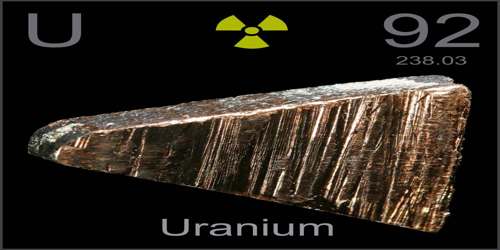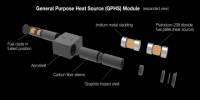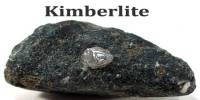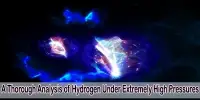Uranium
Definition
Uranium is a heavy, silvery-white, highly toxic, radioactive metallic element of the actinide series. It has 14 known isotopes, of which U 238 is the most naturally abundant, occurring in several minerals. A uranium atom has 92 protons and 92 electrons, of which 6 are valence electrons. Uranium is weakly radioactive because all isotopes of uranium are unstable, with half-lives varying between 159,200 years and 4.5 billion years.
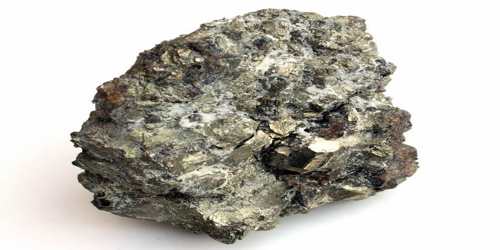
Fissionable isotopes, especially U 235, are used in nuclear reactors and nuclear weapons. Its atomic number 92; atomic weight 238.03; melting point 1,132°C; boiling point 3,818°C; specific gravity 18.95; valence 2, 3, 4, 5, 6.
Uranium is naturally radioactive, which means that atoms of uranium are unstable and decay by emitting particles and energy. Uranium decays very slowly by emitting an alpha particle. For many years, uranium was used primarily as a colorant in ceramic glazes, producing colors that ranged from orange-red to lemon yellow. It was also used for tinting in early photography.
Occurrences and Properties of Uranium
Uranium was found to be radioactive in 1896 by Antoine H. Becquerel, a French physicist. Becquerel had left a sample of uranium on top of an unexposed photographic plate, which became cloudy. Uranium naturally contains all three isotopes (U-238, U-235 and U-234).
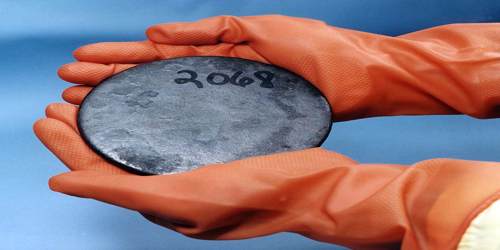
Uranium is a naturally occurring element that can be found in low levels within all rock, soil, and water. Uranium is the 51st element in order of abundance in the Earth’s crust. Uranium is also the highest-numbered element to be found naturally in significant quantities on Earth and is almost always found combined with other elements. The decay of uranium, thorium, and potassium-40 in the Earth’s mantle is thought to be the main source of heat that keeps the outer core liquid and drives mantle convection, which in turn drives plate tectonics.
All isotopes of uranium are radioactive. Three of these occur naturally, uranium-234, uranium-235, uranium-238. By far the most common is uranium-238, making up about 99.276% of uranium found in the Earth’s crust. Uranium-238 also has the longest half life, about 4,468,000,000 years.
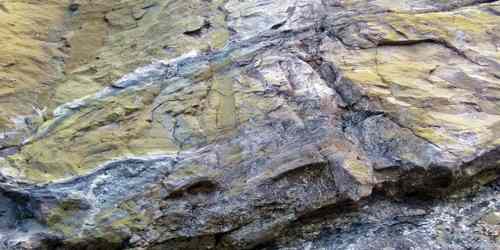
Uranium is a silvery, shiny metal that is both ductile and malleable. Ductile means capable of being drawn into thin wires. Malleable means capable of being hammered into thin sheets. Its melting point is 1,132.3°C (2,070.1°F) and its boiling point is about 3,818°C (6,904°F). Its density is about 19.05 grams per cubic centimeter. It is a relatively reactive element. It combines with nonmetals such as oxygen, sulfur, chlorine, fluorine, phosphorus, and bromine. It also dissolves in acids and reacts with water. It forms many compounds that tend to have yellowish or greenish colors.
Uses of Uranium
Uranium compounds have been used to color glass and ceramics for centuries. Scientists have found that glass made in Italy as early as A.D. 79 was colored with uranium oxide. They have been able to prove that the coloring was done intentionally.
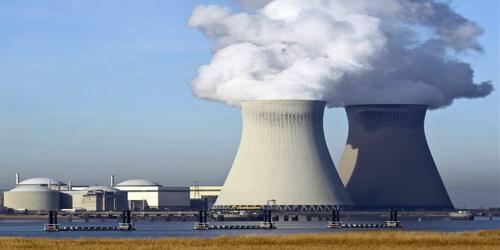
Besides nuclear power plant fuel, U has numerous other military and civilian uses. Uranium and other radionuclides are used by nuclear medicine (MRIs, X-rays, radioisotope injections, radiation treatment, etc.), scientific research (age-dating materials, compositional information, metabolic studies, etc.), agriculture (irradiating food and seeds), consumer products (smoke detectors, watches, irradiating bandages and other items to sterilize them, computer components, etc), materials testing for numerous industries (automotive, aircraft, construction, mining and oil) and space exploration (fuels). In addition, depleted uranium (DU) has been used for counterweights in sail boat’s keel, ballast in boats, pigments and radiation shielding.
Depleted uranium is used by the military for its armour piercing capabilities as penetrators, and highly enriched (>90% U-235) Uranium is used by the military for weapons.
Reference:
